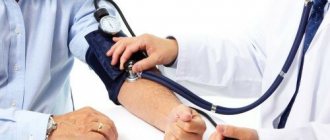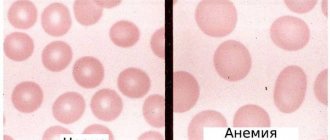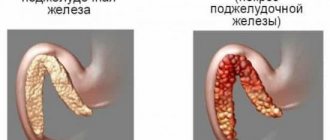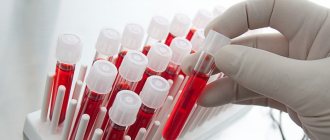Function of cholesterol in the body
According to its chemical structure, cholesterol belongs to the class of lipophilic alcohols. It is vitally necessary for the body, as it is an integral part of cell membranes and is involved in the synthesis of:
- hormones - testosterone, cortisol, aldosterone, estrogens, progesterone;
- vitamin D3;
- bile acids.
About 80% of cholesterol is produced by various human organs (mainly the liver), 20% enters the body with food.
This substance does not dissolve in water, so it cannot move through the bloodstream on its own. To do this, it binds to special proteins - apolipoproteins. The resulting complexes are called lipoproteins.
Some of them have a high density (HDL), others have a low density (LDL). The former remove excess fat from the body, the latter settle on the vascular walls, participating in the formation of atherosclerotic plaques.
Formation of atherosclerotic plaques
Therefore, when we talk about “good” lipids, we mean HDL, and when we talk about “bad” lipids, we mean LDL. Total cholesterol is the sum of all lipoproteins.
A study of lipid metabolism is carried out in order to assess a person’s risk of developing atherosclerosis and cardiovascular complications.
Despite the fact that men and women have different levels of cholesterol in the blood (the table by age is given below), there are regulated indicators in medicine.
The global network provides abundant information on cholesterol standards. Often, figures are given that absolutely do not correspond to the real ones used by doctors. There are official orders, resolutions, and guidelines that indicate clear boundaries of the minimum and maximum indicators.
Victoria Druzhikina
Neurologist, Therapist
Doctors in their practice are guided by the figures recommended by the World Health Organization. They look like this:
| Meaning | Total cholesterol (indicator, mmol/l) | LDL (indicator, mmol/l) | HDL (indicator, mmol/l) | Triglycerides (indicator, mmol/l) |
| normal | up to 5.0; | up to 3.0 | no more than 1.0 | less than 1.7 |
| elevated | 5,0-6,1 | 3,0-3,5 | 1.0-1.3 for men, 1.3-1.5 for women; | 1,8-2,0 |
| high | more than 6.2 | 3,5-3,9 | less than 1.0 for men, 1.3 for women. | 2,1-2,4 |
| very tall | from 6.5 | above 4.0 | less than 0.7 for men, 0.9 for women. | 2.4 and higher |
In his work, the doctor focuses on the range of values he needs, taking into account concomitant diseases. If a person has diabetes, it does not matter what age he is - his cholesterol should be no more than 5.0 mmol/l. Exceeding this figure worsens the prognosis.
Atherogenic index
This coefficient is considered as the difference between high and low density lipoproteins. A special formula is used: Total cholesterol - HDL divided by LDL.
The atherogenicity index is used as an indicator that describes the risk of developing pathological processes. In particular, atherosclerosis. The norms are approximately the same throughout the patient’s life.
- In young people, the level is in the range of 2.5-3 units (the value is dimensionless, since it is a coefficient).
- After 30 years, the permissible value increases slightly: from 3 to 3.5 units.
Attention:
As for patients with diabetes mellitus and others predisposed to the disease, the adequate index is in the range of 4-7.
The indicator of total cholesterol in men and low-density lipoproteins are used to calculate the atherogenicity coefficient. Since this is an integral and, perhaps, the most important indicator among others.
The study is carried out through a simple biochemical blood test.
Normal cholesterol level in women
The table shows the normal level of cholesterol in the blood of women of different ages.
| Age, years | Total cholesterol mmol/l | LDL mmol/l | HDL mmol/l |
| 20-25 | 3,0-5,0 | less than 3.0 | more than 1.2 |
| 25-30 | 3,0-5,0 | less than 3.0 | more than 1.2 |
| 30-35 | 3,0-5,0 | less than 3.0 | more than 1.2 |
| 35-40 | 3,0-5,0 | less than 3.0 | more than 1.2 |
| 41-45 | 3,0-5,0 | less than 3.0 | more than 1.2 |
| 46-50 | 3,0-5,0 | less than 3.0 | more than 1.2 |
| 51-55 | 3,0-5,0 | less than 3.0 | more than 1.2 |
| 56-60 | 3,0-5,0 | less than 3.0 | more than 1.2 |
| 61-65 | 3,0-5,0 | less than 3.0 | more than 1.2 |
| 66-70 | 3,0-5,0 | less than 3.0 | more than 1.2 |
| Over 70 | 3,0-5,0 | less than 3.0 | more than 1.2 |
The age of 40 years is the limit after which there is a high probability of developing vascular and heart diseases associated with atherosclerosis.
As can be seen from the table, in women over 50 years of age, the level of normal cholesterol and LDL in the blood is quite significantly increased. This is due to hormonal changes (which are treated by endocrinologists) that occur during menopause. Metabolic processes slow down at this age, and the body requires more energy to process lipids.
Normal blood cholesterol levels in women after 50 and after 60 years
With the onset of menopause, a woman’s hormonal levels change - the body’s natural defenses from many factors, incl. – the risk of cardiovascular pathologies increases. Therefore, after 50 years, it is especially important to monitor the level of cholesterol and its fractions (LDL, HDL, TG). It is necessary to donate blood annually as part of a free medical examination. If deviations are detected, the frequency of examinations and management tactics for the patient are determined by the doctor. The average cholesterol level for a healthy person after 50 years of age is 3.0 - 5.5 mmol/l. In the presence of concomitant pathology (coronary artery disease, arterial hypertension, diabetes mellitus), the indicator should not be higher than 5.0. For people who have suffered an ischemic stroke - no more than 4.5 mmol/l.
Normal cholesterol level in men
Below is the normal level of cholesterol in the blood of men depending on age.
| Age, years | Total cholesterol | LDL | HDL |
| 20-25 | 3,0-5,0 | less than 3.0 | more than 1.0 |
| 25-30 | 3,0-5,0 | less than 3.0 | more than 1.0 |
| 30-35 | 3,0-5,0 | less than 3.0 | more than 1.0 |
| 35-40 | 3,0-5,0 | less than 3.0 | more than 1.0 |
| 41-45 | 3,0-5,0 | less than 3.0 | more than 1.0 |
| 46-50 | 3,0-5,0 | less than 3.0 | more than 1.0 |
| 51-55 | 3,0-5,0 | less than 3.0 | more than 1.0 |
| 56-60 | 3,0-5,0 | less than 3.0 | more than 1.0 |
| 61-65 | 3,0-5,0 | less than 3.0 | more than 1.0 |
| 66-70 | 3,0-5,0 | less than 3.0 | more than 1.0 |
| Over 70 | 3,0-5,0 | less than 3.0 | more than 1.0 |
If you look closely at the cholesterol levels in the table, you will notice that its level in the blood of men after 60 years of age decreases. This is due to a slowdown in metabolism and regression of all body functions. In men, the risk of atherosclerosis and life-threatening conditions (stroke, heart attack) is initially higher. Their heart and blood vessels are not protected by the action of sex hormones. In addition, representatives of the stronger sex are more often prone to bad habits than women.
Description of the substance and its functions
Chemical properties: able to dissolve only in fat-containing and organic solvents, not in water. Most of it is produced by hepatocytes - liver cells, about 20% comes with food.
The molecule is a necessary component for the synthesis of vitamins D, as well as sex hormones, including testosterone. In addition, the substance is necessary to maintain the elasticity of the cytoplasmic membrane of the cell over a wide temperature range.
Types of lipoprotein complexes
Due to its insolubility in aqueous solvents, the molecule cannot be transported through blood vessels to organs and tissues. Therefore, the substance is found in the human body in the form of a complex with transporter peptides. The complex is called lipoprotein. There are 3 types of lipoprotein complexes: high density (HDL), low (LDL) and very low (VLDL). They differ not only in the functions they perform, but also in the degree of danger to human health.
How to recognize “good” and “bad” lipoprotein? HDL is considered “good” and makes up approximately 30% of the total. The complex consists predominantly of a peptide part. While LDL contains only a small protein part. The accumulation leads to the formation of plaques in the blood vessels, which impede the free flow of blood, and also increases the risk of developing heart pathologies (heart attack and stroke).
The main part of LDL enters the human body along with fatty foods (meat or dairy), leading to its increase to critical values.
Causes of high and low cholesterol
In women and men over 40 years of age, excess cholesterol in the blood may be associated with genetic defects in lipid metabolism, but more often the cause remains unknown. Factors that contribute to increased blood cholesterol levels include:
- liver and gallbladder diseases;
- smoking;
- tumors of the pancreas, prostate gland;
- gout;
- chronic renal failure (the causes and treatment of kidney disease in women are described here);
- endocrine pathology (insufficient production of somatotropic hormone, diabetes mellitus, hypothyroidism).
In women, the cause of increased blood cholesterol compared to the norm can be pregnancy. Those who are planning to get pregnant after 40 need to know this.
Reduced lipid values are observed with:
- starvation, exhaustion;
- extensive burns;
- severe infections (treated by an infectious disease specialist);
- sepsis;
- malignant liver tumors (diagnosed and treated by an oncologist);
- some types of anemia;
- chronic lung diseases (read how to treat chronic bronchitis in this article);
- rheumatoid arthritis;
- hyperthyroidism.
Low blood lipid levels also occur in those who are vegetarians or take medications such as neomycin, thyroxine, ketoconazole, interferon, and estrogens.
Risk groups for high cholesterol
It has been proven that hypercholesterolemia occurs more often in people who:
- eat large amounts of animal fats;
- move little;
- are overweight;
- abuse alcohol;
- smoke;
- take certain medications for a long time (androgens, diuretics, glucocorticoids, cyclosporine, amiodarone, levodopa).
Men over 40 and women over 50 undergo a screening test for blood cholesterol (the norm is indicated in the tables above). It is one of the factors that is taken into account when calculating absolute cardiovascular risk.
Doctor's advice
Nutrition for low cholesterol. You can eat any kind of porridge. If you have poor tolerance to milk protein, you can cook them with water, but it is better with half and half milk and water. There is little cholesterol in milk, especially store-bought milk, but the body needs protein. You can add 1/2 teaspoon of natural butter without vegetable fat to the finished porridge. You can eat this 2-3 times a week. On other days, the porridge should be seasoned with vegetable oil. Today, olive oil is considered the most beneficial in terms of cholesterol. You can also use regular sunflower, sea buckthorn, and camelina. Rapeseed should not be used. Salads should also be seasoned with butter or 10% sour cream instead of mayonnaise.
Victoria Druzhikina Neurologist, Therapist
High and very high absolute risk means that in the coming years a person may suffer from severe and even fatal disorders of the heart and blood vessels.
Hypercholesterolemia is especially dangerous for people suffering from:
- coronary heart disease (therapy is carried out and advised by a cardiologist);
- atherosclerosis of the lower extremities;
- obesity;
- people prone to blood clots;
- chronic kidney diseases;
- hypertension;
- chronic kidney diseases;
- hypertension;
- diabetes mellitus (treated by an endocrinologist);
- collagenoses (for example, rheumatoid arthritis).
These conditions require frequent monitoring of lipids and drug correction if they increase.
After 40 years
The normal level of total cholesterol in men after 40-45 years is in the range of 4.2-7.2 mmol/l. and the likelihood of full-blown deviations at this age increases.
As a rule, patients encounter three disorders:
Cardiac ischemia
It develops against the background of blockage of the coronary arteries by cholesterol plaques. This is an extremely dangerous pathological process. On the other hand, it develops gradually, so there is every chance to notice something is wrong and consult a doctor.
The symptoms of the disorder are quite typical and are well differentiated even by the patient himself.
- Chest pain. Intense, diffuse character. Often localized to one specific point. Just above the epigastric region.
- Discomfort in the area of the left shoulder or arm in general. Unpleasant sensations can radiate to the limbs.
- Disturbances in normal breathing.
- Also decreased performance. The patient constantly or most of the time wants to sleep, and cannot perform even the simplest work.
- Exercise intolerance. Or a decrease in tolerance to mechanical activity. At advanced stages of the pathological process, the patient cannot get out of bed because symptoms such as shortness of breath begin.
- Disturbance of normal heart rhythm. Tachycardia develops. In this way, the heart tries to compensate for the lack of nutrients. Restore trophism and cellular respiration. This is not enough for a long time, so the opposite phenomenon occurs.
- Bradycardia. Decreased heart rate. Develops spontaneously after a long time.
Coronary heart disease is treated by a cardiologist. Conservative therapy is prescribed. In the early stages, cardioprotectors and means to protect the organ are indicated.
If it is ineffective or if the pathological process is advanced, surgery is prescribed. As a rule, they are limited to bypass surgery. They pave an additional path for liquid connective tissue.
Thus, the heart receives a normal amount of blood with nutrients and oxygen.
Hypertonic disease
A chronic disorder characterized by increased blood pressure. In this case, we are talking about a full-fledged disease, and not about a simple phenomenon.
The condition is stable (in the negative sense) and highly dangerous for the patient.
As a rule, there is a group of symptoms:
- Headache. Discomfortable sensations in the skull area. They can be very different: pinpoint, diffuse. Depends on the individual characteristics of the patient’s body.
- Heart rhythm disturbance. Due to increased load on cardiac structures.
- Dizziness. Feeling of the world spinning before your eyes.
- Intolerance to sharp sounds and smells. Especially at the peak of rising blood pressure.
- Nausea.
- Vomiting is possible, but not always.
Symptoms such as weakness and drowsiness will certainly develop. With a long course of the pathological process, the patient simply does not notice many manifestations.
This is a bad sign because the body adapts to high blood pressure levels.
Then, after treatment, it will be difficult to live with normal blood pressure. Your health will change and you will have to get used to the condition again.
Treatment is carried out under the supervision of a cardiologist. In some cases, a neurologist comes into play in order to achieve a greater therapeutic result.
Several types of drugs are prescribed. Calcium channel blockers, centrally acting agents, sartans, ACE inhibitors, diuretics, if necessary.
Correction of pressure is a mandatory measure, since without special help there is a high probability of emergency conditions: heart attack, stroke.
Atherosclerosis
{banner_banstat9}
A classic disease associated with lipid metabolism disorders. Develops as a result of a metabolic disorder.
Fats are stored in excess quantities. Some of the substance is deposited on the walls of blood vessels and large arteries.
In the early stages of hypercholesterolemia, there are no symptoms of the disorder yet. As soon as the pathological process is sufficiently developed, characteristic signs will appear:
- Headache. Usually strong.
- Nausea.
- Vomit.
- Weakness and drowsiness.
- Heart rhythm disturbances.
- Sensation of pulsation in the throat or neck vessels.
- Problems with thinking. By memory. Cognitive functions in general.
Treatment is carried out using special drugs. Statins are used to help clear plaques faster. Also fibrates if the first means are ineffective. Be sure to use nicotinic acid.
It is important that the patient eats a nutritious diet that is low in fat and carbohydrates. Preference is given to plant products.
Recovery takes place under the supervision of an endocrinologist.
What to do if cholesterol is high, how to bring it back to normal
Even among young people, starting from 18 years old, with prof. During examinations and medical examinations, blood is taken for total cholesterol. If it is elevated, the doctor gives recommendations for lifestyle changes. Compliance with them can delay the occurrence of vascular atherosclerosis and related complications.
To do this, first of all, you need to change your diet. The following should be excluded from it:
- fatty meat, sausage, smoked meats, lard, offal;
- mayonnaise, fatty sauces;
- fatty dairy products (cream, cheese, sour cream);
- confectionery, flour products;
- carbonated drinks;
- canned foods, semi-finished products;
- alcohol;
- margarine.
In the daily menu it is better to give preference to:
- vegetable salads with the addition of vegetable oil;
- sea fish;
- lean meat;
- fresh vegetables, fruits;
- porridge on water;
- vegetable soups or soups cooked in low-fat broth;
- low-fat fermented milk products;
- mineral water, unsweetened berry fruit drinks, freshly squeezed juices;
- whole grain, rye or bran bread.
Changing your diet: Your health is in your hands
Low physical activity negatively affects the level of “bad” lipids. Therefore, young people should play sports, the elderly and sick should walk at a moderate pace, climb the stairs to their floor.
In women over 50 years of age receiving hormone replacement therapy due to menopausal syndrome, cholesterol increases compared to the norm. Before starting hormonal medications, they should visit a general practitioner or cardiologist.
People who have diseases that are dangerous in terms of absolute cardiovascular risk should constantly take lipid-lowering drugs. These include fibrates, statins, etc. They stabilize atherosclerotic plaques, that is, they do not allow them to collapse. The destruction of the plaque entails necrosis of the vessel or its detachment and entry into the vascular bed in the form of a thrombus. Thrombosis and necrosis of cardiac vessels lead to myocardial infarction, and cerebral vessels lead to stroke.
How to prepare for donating blood for cholesterol?
The biomaterial for research is taken by a laboratory specialist from a vein in the patient’s elbow. The completion time does not exceed 24 hours, not counting the day on which the biomaterial was collected.
More than 70% of errors are made at the preanalytical stage, that is, at the stage of preparing the subject for analysis and during the procedure for taking material. Recommendations for preparing for analysis:
- biomaterial is submitted strictly on an empty stomach, the minimum time interval between a visit to the laboratory and a meal should be 6 hours;
- smoking is eliminated within half an hour;
- per day, adjustments are made to the diet: fatty and smoked foods are excluded;
- physical and emotional activity is limited, as this affects the condition and functioning of tissues in the human body;
- 2-3 days in advance, it is advisable to avoid taking any medications in consultation with your doctor. If cancellation is impossible, you must notify the laboratory employee.
Read more: How long does alcohol stay in the blood; about maintenance standards
Cholesterol lowering drugs
Currently, the following groups of drugs are used to lower cholesterol:
| Group | Action | International name | Tradename |
| Statins | Reduces LDL and triglycerides | "Simvastatin"; "Atorvastatin"; "Rosuvastatin"; "Fluvastatin"; "Lovastatin"; "Pravastatin" | "Simvastol", "Vasilip"; "Atoris", "Liprimar"; "Rocksera"; "Mertenil"; "Leskol"; "Mevacor"; "Lipostat"; |
| Bile acid binding resins | Reduce LDL | "Cholestyramine"; "Colestipol"; "Kolesevelam" | "Questran"; "Colestid"; "VelHol" |
| Cholesterol absorption inhibitors | Reduce LDL and triglycerides, increase HDL | "Ezetemibe" | "Zetia" |
| Fibrates | Reduce triglycerides, increase HDL | "Fenofibrate"; "Gemfibrozil" | "Lofibra", "Trikor"; "Dopid" |
| Combined (statin + cholesterol absorption inhibitor) | Reduce LDL and triglycerides, increase HDL | "Ezetemibe+"Simvastatin" | "Vytorin" |
1st line drugs are statins. The oldest representative is Simvastatin. Its use is justified when you need to slightly lower cholesterol levels, plus it is low in cost, it prevents the creation of new cholesterol deposits, but also does not reduce old ones. Reducing plaque requires a dose that is toxic to the liver.
Rosuvastatin and Atorvastatin are considered the most effective and safe. They have been tested by the practice of millions of doctors and hundreds of clinical studies, and have been proven to reduce the volume of atherosclerotic plaques.
New drugs include Pravastatin; they also effectively combat the problem, but do not have a large evidence base and many years of experience in use.
Taking statins requires mandatory monitoring of liver function. To do this, blood is donated monthly or once every 2 months for liver fractions (ALT, AST). At the same time, cholesterol levels and lipid levels are monitored.
Find out about the normal level of cholesterol in the blood from the video:
This article has been verified by a current qualified physician, Victoria Druzhikina, and can be considered a reliable source of information for site users.
Bibliography
1. https://scardio.ru/rekomendacii/rekomendacii_rko_close/
2. https://scardio.ru/rekomendacii/rekomendacii_esc_close
Rate how useful this article was
4.6 43 people voted, average rating 4.6
Did you like the article? Save it to your wall so you don’t lose it!
Treatment and prevention
The diet is aimed primarily at reducing the total body weight of a person:
- It is advisable to exclude offal, as well as fatty fish and meat. Preference is given to chicken and turkey meat, lean varieties of beef are acceptable;
- Cottage cheese, yogurt, sour cream, kefir with a high percentage of fat content are removed from the diet, low-fat fermented milk products are allowed, but not more than once a day;
- the maximum permissible percentage of fat content for cheese should not exceed 30;
- The yolks are extracted from boiled eggs, the whites can be consumed in unlimited quantities;
- It is recommended to significantly reduce the amount of salt consumed;
- sweets are kept to a minimum, ideally eliminated completely;
- Products that are strictly prohibited include: sunflower oil, mayonnaise, and sauces.
The preferred cooking method is boiling, stewing or steaming; frying will have to be excluded. It is recommended to eat on a schedule, no more than five times a day.
Recent studies conducted by scientists in the USA have made it possible to establish a direct relationship between the type of coffee consumed and the value of the indicator in question. Thus, instant coffee has an increasing effect, so people with hypercholesterolemia are recommended to drink exclusively natural coffee without sugar.











